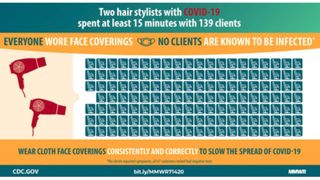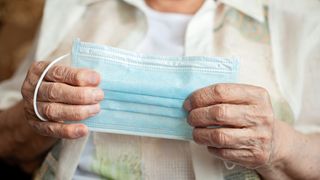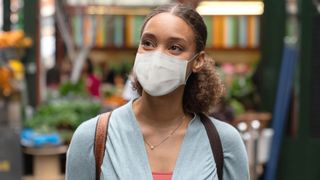For anyone still doubting whether face masks slow the spread of the coronavirus, science has dished out some irrefutable proof this week. And the timing couldn’t be better, with confirmed cases of COVID-19 hitting record highs in some states, and the director of the CDC, Robert Redfield, stating in a July 14 press release: “If we could get everybody to wear a mask right now I think in four, six, eight weeks we could bring this epidemic under control.”
Two new studies, both published this week, highlight what a difference face masks make. In the first study, researchers looked at how mask use in a Massachusetts hospital significantly reduced the rate of coronavirus infection. Before a mask mandate was introduced in the state, infection rates among hospital staff were increasing at a rate of 1.16% a day. After the mask mandate came into force, wherein patients and staff had to wear masks, the rate declined to 0.49% a day.
The second study, published by the CDC, centers around a hair salon in the city of Springfield, Missouri, where two hair stylists developed coronavirus symptoms before later testing positive for COVID-19.
Before taking leave for COVID-19, between them the hair stylists served 139 customers. How many of those customers and the stylists’ co-workers became infected? Zero. Why? Because the stylists wore face masks, and so did their clients and colleagues.

Despite science clearly proving that proper face mask use slows the spread of the coronavirus, there will still be some who refuse to believe it. In fact, whether or not we need to wear masks is still one of the most common coronavirus questions. Thankfully, anti-maskers are in the minority, as last month the Pew Research Center revealed that:
- 65% of US adults say they have worn a mask in stores or other businesses all or most of the time in May/June
- 15% say they did some of the time during the same period
- 9% say they hardly ever wore a mask in the past month
- 7% said they didn’t wear one at all
- 4% said they have not gone to these types of places
Understandably, COVID-19 death rates in counties play a role in whether the people there wear masks. According to the Pew Research Center, ‘About six-in-ten adults (62%) who live in counties with the highest COVID-19 death rates say that all or most people in their communities are wearing masks, compared with 33% of those who live in areas that have the lowest number of coronavirus deaths per capita.’

Ok, so we now know that wearing a mask, whether that’s a homemade face mask or a 3-ply disposable mask, can help protect us and those around us from the coronavirus. Good. So how can we tell if we’re wearing the right type of face mask?
These are the signs that you’re wearing the wrong (non-protective) type of face mask:
- The mask restricts your breathing
- It sags around your mouth and nose
- The material is pretty much see-through (transparent)
- It becomes damp very quickly
- It has just one layer of fabric
- The material is visibly porous (has holes)
- There are gaps around the sides of the mouth and nose
- The mask shrinks or breaks apart when washed
- It’s a thin scarf drafted in as a make-shift mask
Thankfully, we have a ton of information to help sort the protective masks from the ones that offer little barrier between your respiratory system and the virus. Recently, face mask guidance for over-60s changed, with the World Health Organization (WHO) recommending adults aged 60 and over to wear medical masks in areas with active virus transmission.
Medical masks are also recommended if someone in your home is sick with COVID-19 - they should wear a mask when in close proximity to you and vice versa. Ideally, ask them to stay in one room to avoid infecting your entire home; an essential measure after learning that beds are a potential COVID-19 hotspot.
The gold standard for face masks is a three-layer covering, which includes a dedicated pocket for a filter material such as toilet paper or a coffee filter, and a moldable nose bridge wire to better fit the mask to your mask.
The World Health Organization also has a video on how to wear a medical mask, for over-60s or those with a confirmed case of COVID-19 at home.
What to look for when buying or making a face mask
If you’re making your own face mask, choose thick yet breathable materials and have at least two layers so that it’s harder for the virus to get a straight shot at your mouth and nose. If you’re unsure whether the material is good enough, hold it up to the light. If light passes through easily, choose something denser, like thick cotton, flannel weave or denim.
Make a filter pocket in your mask and include a removable filter material. Again, it’s all about breathable, protective layers. When it comes to how often you should wash your face mask, the advice is clear: after every use, so have a few masks in rotation.
Wondering where to buy reusable fabric face masks online? You have plenty of options available, but some masks are superior to others, so ensure the one you’re buying follows health guidelines. That means the mask must:
- Fit snugly but comfortably
- Be secured with ties or ear loops
- Include multiple layers of fabric
- Be able to be laundered and dried without change to shape
Face masks are no substitute for social distancing
To stay as safe as possible throughout the ongoing pandemic, make sure you follow the CDC’s updated coronavirus guidelines on how to protect yourself when outside your home, maintain social distancing, washing your hands regularly, and avoiding areas where the virus is active.
Where possible, avoid contact with symptomatic friends and family who live outside of your household. A new cough and fever are the most common symptoms of coronavirus, and you can easily monitor a rising temperature with the best digital thermometers.
A face mask needn’t cost the earth, but, as science has now proven, they can make a big difference in how many of us are infected with the coronavirus - and how many have to live with the consequences of this illness afterwards.
The cost of COVID-19 treatment is a concern for many Americans, in addition to costs associated with existing conditions, so now is the time to consider which of the best health insurance companies are capable of meeting your needs. For help with ongoing prescription drugs costs, take a look at our guide to the best Medicare Part D plans.

